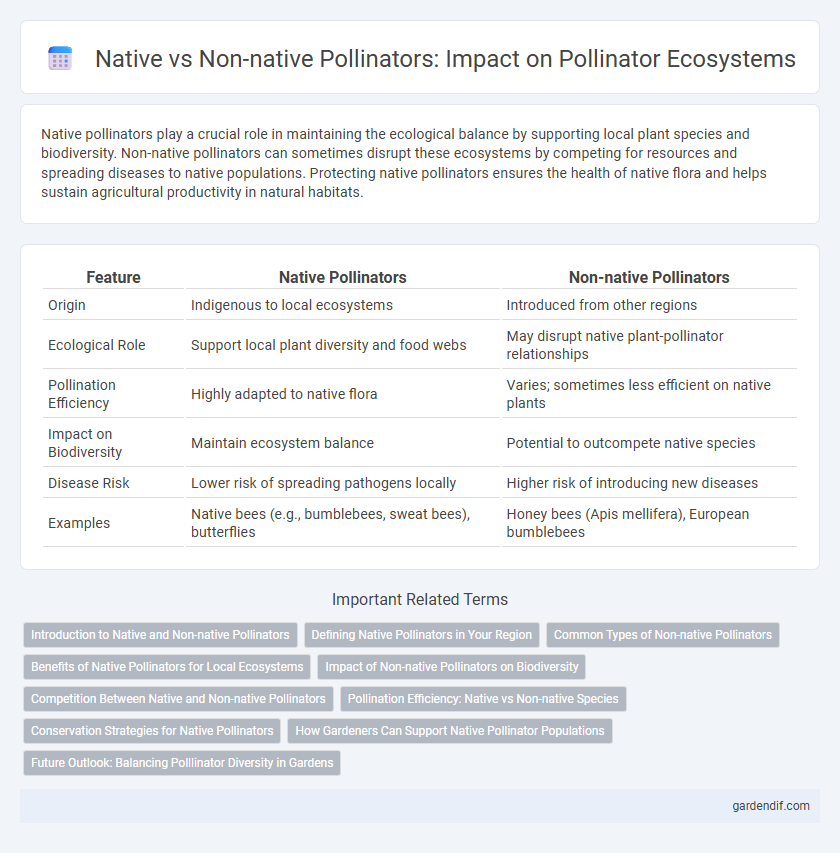
Native Pollinators vs Non-native Pollinators Illustration
Native pollinators play a crucial role in maintaining the ecological balance by supporting local plant species and biodiversity. Non-native pollinators can sometimes disrupt these ecosystems by competing for resources and spreading diseases to native populations. Protecting native pollinators ensures the health of native flora and helps sustain agricultural productivity in natural habitats.
Table of Comparison
| Feature | Native Pollinators | Non-native Pollinators |
|---|---|---|
| Origin | Indigenous to local ecosystems | Introduced from other regions |
| Ecological Role | Support local plant diversity and food webs | May disrupt native plant-pollinator relationships |
| Pollination Efficiency | Highly adapted to native flora | Varies; sometimes less efficient on native plants |
| Impact on Biodiversity | Maintain ecosystem balance | Potential to outcompete native species |
| Disease Risk | Lower risk of spreading pathogens locally | Higher risk of introducing new diseases |
| Examples | Native bees (e.g., bumblebees, sweat bees), butterflies | Honey bees (Apis mellifera), European bumblebees |
Introduction to Native and Non-native Pollinators
Native pollinators, including bumblebees, honeybees, and butterflies, have co-evolved with local plants, ensuring efficient pollination and supporting biodiversity. Non-native pollinators, such as the European honeybee introduced to North America, can supplement pollination but sometimes compete with native species and disrupt ecosystems. Understanding the roles and impacts of both native and non-native pollinators is essential for conservation and agricultural productivity.
Defining Native Pollinators in Your Region
Native pollinators are species that have evolved naturally within a specific region, maintaining long-standing ecological relationships with local flora. These pollinators include bees, butterflies, moths, birds, and bats uniquely adapted to regional plant species and climate conditions. Defining native pollinators involves identifying species endemic to your area, ensuring their conservation supports local biodiversity and ecosystem health.
Common Types of Non-native Pollinators
Common types of non-native pollinators include the European honeybee (Apis mellifera), which is widely managed for agricultural pollination but can outcompete native species. Other non-native pollinators such as the buff-tailed bumblebee (Bombus terrestris) and the alfalfa leafcutter bee (Megachile rotundata) are introduced for crop-specific pollination services. These non-native species often impact local ecosystems by altering pollination networks and potentially spreading diseases to native pollinators.
Benefits of Native Pollinators for Local Ecosystems
Native pollinators enhance local ecosystems by supporting the reproduction of indigenous plants, which maintains biodiversity and ecosystem resilience. They are adapted to the specific flowering times and structures of native flora, ensuring more effective pollination and higher seed set. Their presence also promotes habitat stability, benefiting other native wildlife and contributing to overall ecological balance.
Impact of Non-native Pollinators on Biodiversity
Non-native pollinators often compete with native species for floral resources, leading to reduced native pollinator populations and altered plant-pollinator networks. The introduction of non-native pollinators can disrupt local ecosystems by spreading diseases and hybridizing with native pollinator species. Such impacts contribute to diminished biodiversity and compromise the resilience of native plant communities.
Competition Between Native and Non-native Pollinators
Native pollinators, including various species of bees, butterflies, and beetles, are crucial for local ecosystem stability and the pollination of native plants. Non-native pollinators, such as the European honeybee (Apis mellifera), often compete with native species for floral resources, potentially causing declines in native pollinator populations. This competition can disrupt pollination networks, reduce biodiversity, and negatively impact agriculture reliant on native pollinator species.
Pollination Efficiency: Native vs Non-native Species
Native pollinators demonstrate higher pollination efficiency due to their coevolutionary relationships with local plant species, resulting in better pollen transfer and increased fruit set. Non-native pollinators often exhibit less specialized behavior, which can reduce pollination quality and disrupt native plant reproduction. Studies indicate that reliance on native pollinators supports ecosystem stability by maintaining effective pollination networks and biodiversity.
Conservation Strategies for Native Pollinators
Conservation strategies for native pollinators prioritize habitat restoration and the preservation of native plant species critical for their survival. Supporting diverse floral resources throughout the growing season enhances native pollinator nutrition and resilience against environmental stressors. Reducing pesticide use and implementing pollinator-friendly land management practices further safeguard native pollinator populations essential for ecosystem stability and crop pollination.
How Gardeners Can Support Native Pollinator Populations
Gardeners can support native pollinator populations by planting a diverse range of native flowering plants that provide essential nectar and pollen sources throughout the growing season. Creating habitats such as bee hotels, leaving patches of bare soil for ground-nesting bees, and avoiding pesticide use further enhance native pollinator health and reproduction. Prioritizing native plant species ensures the preservation of local pollinators adapted to regional ecosystems, improving pollination efficiency and biodiversity.
Future Outlook: Balancing Polllinator Diversity in Gardens
Native pollinators play a critical role in maintaining local ecosystems due to their co-evolution with native plants, ensuring effective pollination and biodiversity support. Non-native pollinators can supplement pollination services but sometimes compete with native species, potentially disrupting ecological balance. Future garden designs should prioritize planting native flora to support indigenous pollinators while carefully managing non-native introductions to maintain pollinator diversity and ecosystem health.
Native Pollinators vs Non-native Pollinators Infographic

 gardendif.com
gardendif.com